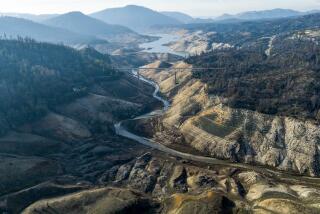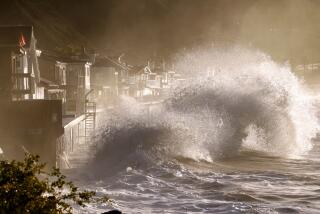End of El Nino Doesn’t Offer a Silver Lining
- Share via
The last time weatherman extraordinaire Nicholas Graham had his computer forecast the future, we were hearing about a little something called El Nino. Well, Graham and his computer are at it again. The result: a weather pattern that may be less sodden but not gentler, and may hit the state next winter with its own bag of dirty tricks, he says.
If computer models are as accurate as they were the first time around, the new phenomenon could bring colder and drier conditions that may even lead to a drought, says Graham, who works for the International Research Institute for Climate Prediction at Scripps Institution of Oceanography in La Jolla.
Some call the pattern La Nina. Its expected high winds, combined with dry vegetation, might create fire hazards. That’s important news to fire officials, who want to make sure the overpowering wildfires that struck Malibu and Laguna Beach in 1993 are not repeated.
Graham warns that his forecast, which is based on water temperatures in the eastern Pacific Ocean off South America, “is probabilistic,” meaning it could all change. But the prediction comes from the same computer models Graham generated last summer for a surprisingly precise forecast of El Nino.
Graham, whose early prediction for an El Nino year of twice to three times the normal rainfall proved true, takes comfort in knowing that many disaster officials listened. He has since become known as one of the foremost experts on El Nino.
Officials are taking Graham’s newest prediction seriously, saying they will begin to formulate plans to prevent fires and to make sure reservoirs have plenty of water.
“The fact that temperatures are going to be a little colder and less rainfall is predicted is a pretty simplistic view of it,” said Richard Masters, maintenance operations supervisor for the 6,000-student Huntington Beach City School District. Like other districts, it scrambled to patch roofs and ceilings to keep classrooms dry during El Nino.
“With that forecast, you can get very high winds and fire hazards. Next year is also the highest tide year in a seven-year cycle, which is also a concern for us because we’re in a beach community,” he said.
With an abundance of dry grassy fuel and the potential for Santa Ana winds, Orange County Fire Authority Capt. Scott Brown said “it could be a recipe for fire problems.”
Winds not only fan fire, but play a role in drying brush into tinder, said Los Angeles County Assistant Fire Chief Stephen Alexander. “One of the things that El Nino did for us was create a huge fuel load of mostly new vegetation that with winds can desiccate or dry out fuels within as short a time as two days.”
Additionally, Alexander, who is in charge of firefighting services for an area covering many hillside communities in Agoura, Westlake, Hidden Hills and the Malibu coast, said the department will put more fire engines on response and also rely on firefighting aircraft such as the department’s Super Scooper aircraft during months of predictable high winds.
During California’s six-year drought that began in 1986, agencies imposed water restrictions. But fire officials said the restrictions did not hamper firefighting capability.
“You bet we will be listening and watching weather forecasts from now on,” said Robert Eichblatt, Huntington Beach city engineer. “We spent $300,000 in getting ready for this El Nino because it was a wake-up call for us. We now own a sandbagger that can feed four sandbags at a time.”
Laguna Beach Battalion Chief Mark Baker said that in his experience, big fires occur in the second summer after a heavy El Nino year because hillsides can remain saturated with water for months.
“If La Nina predictions come through with a colder and drier winter, we could be looking at two summers in a row that could pose significant fire threats,” Baker said.
Baker’s department was among those invited from throughout the Southland last year when climate researchers such as Graham helped lay the groundwork for El Nino preparations for public works and emergency disaster officials at Scripps.
El Nino’s fury caused more than $58 million in damage in Orange County and an estimated $550 million damage statewide. Meanwhile, rainfall records across the state fell. A record amount of rainfall--31.46 inches--fell in Santa Ana this past rainy season, wiping out the old record of 31.02 set in 1978, said a spokesman for WeatherData Inc., which provides forecasts for The Times.
As dry as the new pattern might prove, some officials believe the soggy aftermath isn’t over. They point to recent landslides in South Orange County and along Pacific Coast Highway in Malibu as evidence that hillsides remain unstable.
Mike Tope, chief ranger for state parks and beaches in south Orange County, said rangers were forced to close several hiking trails for fear of slides.
“We hired a geologist who told us that the water that is percolating now is early season rainfall,” Tope said. “It’s lubricating some of the sediment layers and we have unstable sections that get wet and it’s causing slides.”
The bottom line, officials said, is they will keep an eye on daily weather forecasts for major changes.
“I’m glad that more people are saying they have to watch the weather reports and the climate signals,” Graham said. “You can still get a huge rainstorm in the middle of a La Nina year.”
(BEGIN TEXT OF INFOBOX / INFOGRAPHIC)
A year of La Nina
Expect cold water and warm Santa Ana winds this year, with the arrival of the weather phenomenon, La Nina.
La Nina Conditions
Strong trade winds from east; large mass of cold water along eastern Pacific.
*
Normal Conditions
Normal trade winds; cold water along eastern Pacific.
*
El Nino Conditions
Weak trade winds; warm water along eastern Pacific.
Sources: Scripps Institute of Oceanography, National Oceanic and Atmospheric Assn. Researched by DAVID REYES / Los Angeles Times
More to Read
Sign up for Essential California
The most important California stories and recommendations in your inbox every morning.
You may occasionally receive promotional content from the Los Angeles Times.













